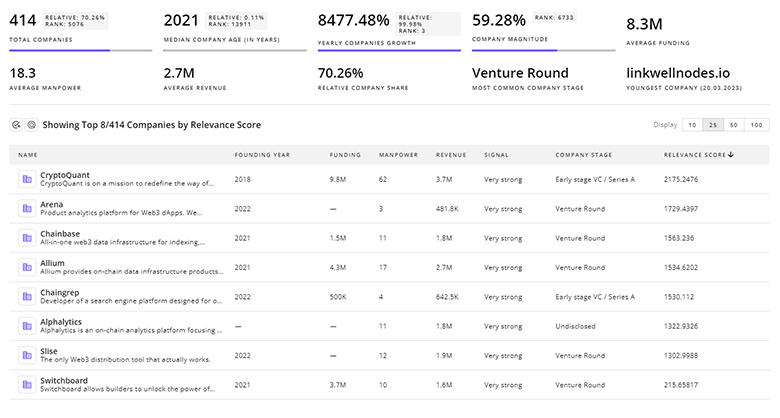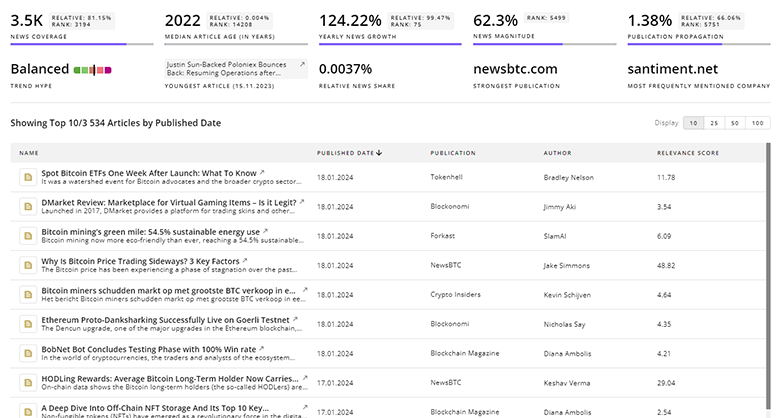
Sustainable Ocean Resources Report
: Analysis on the Market, Trends, and TechnologiesThe sustainable ocean resources sector is maturing into a capital- and data-intensive blue economy segment: it registers a market CAGR of 5.5% and has mobilised about $3.04 billion in sector funding, signaling commercialisation across aquaculture, blue carbon, ocean energy and ocean data services. Policymakers and investors now prioritise integrated projects that combine monitoring, regenerative biomass (seaweed, shellfish) and modular renewable power to reduce lifecycle cost and concentrate measurable climate and food-security outcomes (see policy and market roadmaps cited below) (Transformations for a Sustainable Ocean Economy, Global Sustainable Seafood Market 2025).
31 days ago, we last updated this report. Notice something that’s not right? Let’s fix it together.
Topic Dominance Index of Sustainable Ocean Resources
To gauge the influence of Sustainable Ocean Resources within the technological landscape, the Dominance Index analyzes trends from published articles, newly established companies, and global search activity
Key Activities and Applications
- Sustainable aquaculture (land-based RAS, semi-closed sea cages, IMTA) that reduces effluent, increases biosecurity and enables local supply chains.
- Seaweed farming and blue carbon projects that sequester CO2, produce feed/biomaterials and create revenue via carbon and product markets (Canopy Blue project descriptions).
- Marine ecosystem restoration (oyster reefs, seagrass, artificial reef substrates) deployed as living coastal protection and fisheries habitat enhancement (GRoW Oyster Reefs).
- Ocean data and surveillance (satellite, USVs, AI analytics) for fisheries enforcement, MSP and production optimisation (Global Fishing Watch).
- Marine renewable energy and hybrid offshore platforms (wave, tidal, OTEC and integrated wind/solar/wave hybrids) to supply power for ocean farms, desalination and local grids (NoviOcean AB, Global OTEC, Ocean Energy Market 2025).
- Ocean waste recovery and circular-use (collection, polymer recycling, biorefinery of sidestreams) that convert debris and processing by-products into saleable feedstocks and materials (#tide®, Waste Free Oceans,).
Emergent Trends and Core Insights
- Data-first governance is mainstreaming: near-real-time satellite plus persistent USV/AUV coverage is becoming a precondition for enforceable MSP and quota systems; transparency reduces illegal activity and improves supply-chain trust.
- Product-grade seaweed and large-scale kelp cultivation are shifting from pilot to commercial scale, creating stacked revenue streams (biostimulants, feed, carbon credits) and stronger investor interest in blue carbon credits (Blue Economy market forecasts).
- Integrated offshore systems gain financial appeal: coupling aquaculture, wave/tidal power and monitoring lowers onsite energy cost and increases resilience to grid constraints—this underpins investor interest in hybrid platforms.
- Circular processing upgrades economic value from fisheries sidestreams and shell waste; biorefineries and feed upcycling reduce pressure on wild stocks and improve margins for processors.
- Finance and policy alignment remains the gating factor: the 100% sustainable-management by 2030 ambition and UN/alliances create deadlines for national commitments and blended finance to scale projects in SIDS and LDCs (Achieving 100% Sustainable Ocean Management, WRI 2025 briefing).
Technologies and Methodologies
- Recirculating Aquaculture Systems (RAS) and modular land-based LARA units for controlled, low-discharge seafood production (Blue Planet LARA).
- Autonomous surface vehicles (solar USVs) and persistent sensor arrays feeding AI analytics for enforcement, biomass mapping and operational control.
- Seaweed biorefinery processes and circular feed/ingredient extraction (mechanical/chemical separation, fractionation) that monetise multiple product streams from cultivated biomass (Coral Bioworks biorefinery, Merall Bioproducts circular line).
- Hybrid offshore energy converters (combined wave/wind/solar; OTEC modules) and modular subsea power for remote island and farm electrification.
- Habitat engineering (biomimetic concrete reefs, oyster scaffolds, seagrass planting) paired with monitoring and outcome verification for blue carbon and coastal protection credits.
- Direct Ocean Capture and seawater CO2 removal approaches as complement to nature-based projects for verified carbon removal inventories (Captura DOC technology,).
Sustainable Ocean Resources Funding
A total of 173 Sustainable Ocean Resources companies have received funding.
Overall, Sustainable Ocean Resources companies have raised $6.7B.
Companies within the Sustainable Ocean Resources domain have secured capital from 609 funding rounds.
The chart shows the funding trendline of Sustainable Ocean Resources companies over the last 5 years
Sustainable Ocean Resources Companies
- Oceanloop — Oceanloop develops software-controlled, modular land-based RAS farms for shrimp and grouper and operates two clearwater RAS facilities in Germany; the company is scaling with a RAS-Tech Centre and plans an industrial RAS farm in Spain, positioning itself to serve regional fresh-seafood supply chains and reduce marine impacts from open-net farms.
- AquaFood AB — AquaFood commercialises upcycling technology that extracts high-value protein and omega-3 oil from seafood processing sidestreams, enabling processors to retain more nutritional value from each fish and reduce pressure on wild harvests while creating feed and ingredient revenue.
- Kelp Blue — Kelp Blue grows giant kelp at commercial scale to sequester carbon and produce biostimulants (StimBlue+) for agriculture; the model stacks ecological restoration with revenue from crop inputs and other seaweed-based products, supporting coastal employment and carbon claims.
- Open Ocean Robotics — Open Ocean Robotics deploys solar-powered USVs that collect persistent ocean data (sensors, cameras, comms) to detect fisheries activity, map biomass and feed operational AI models; its platform lowers the cost of continuous monitoring for managers and researchers.
- ORA Estuaries — ORA designs and grows living oyster-reef infrastructure (Oyster Scaffold) for coastal protection and fisheries enhancement; the company couples habitat engineering with community partnerships to deliver shoreline resilience and local economic benefits.
Get detailed analytics and profiles on 993 companies driving change in Sustainable Ocean Resources, enabling you to make informed strategic decisions.

993 Sustainable Ocean Resources Companies
Discover Sustainable Ocean Resources Companies, their Funding, Manpower, Revenues, Stages, and much more
Sustainable Ocean Resources Investors
TrendFeedr’s Investors tool provides an extensive overview of 545 Sustainable Ocean Resources investors and their activities. By analyzing funding rounds and market trends, this tool equips you with the knowledge to make strategic investment decisions in the Sustainable Ocean Resources sector.

545 Sustainable Ocean Resources Investors
Discover Sustainable Ocean Resources Investors, Funding Rounds, Invested Amounts, and Funding Growth
Sustainable Ocean Resources News
Explore the evolution and current state of Sustainable Ocean Resources with TrendFeedr’s News feature. Access 2.0K Sustainable Ocean Resources articles that provide comprehensive insights into market trends and technological advancements.

2.0K Sustainable Ocean Resources News Articles
Discover Latest Sustainable Ocean Resources Articles, News Magnitude, Publication Propagation, Yearly Growth, and Strongest Publications
Executive Summary
The business case for sustainable ocean resources rests on three practical pillars: measurable productivity gains from advanced aquaculture and biorefinery operations; revenue stacking from blue carbon, product streams and traceability premiums; and cost reductions enabled by on-site renewable power and autonomous monitoring. Investors and operators who integrate those components into project design—backed by verifiable measurement, accessible financing structures for SIDS and transparent data platforms—will capture early mover advantages while delivering verifiable climate and food-security outcomes. Policy timelines (national sustainable ocean plans and the 2030 management targets) create an execution window for commercial scaling; companies that align technical design with creditable verification and local partnership models will convert policy momentum into sustainable, bankable deployments.
We're looking to collaborate with knowledgeable insiders to enhance our analysis of trends and tech. Join us!






